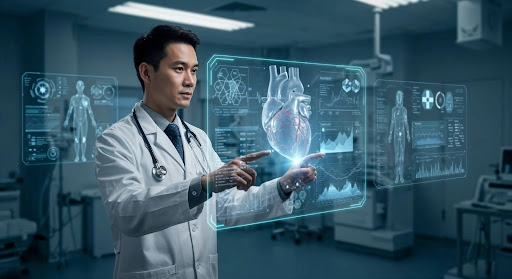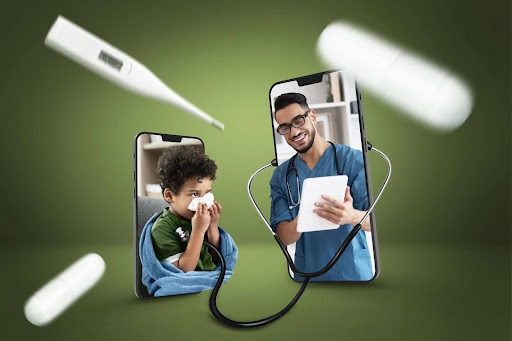From Stethoscope to Start-ups: The Prescription for Change

A significant trait of human intelligence is our ability to look at the past to predict what might happen in the future. It is something that Artificial Intelligence (AI), as an emerging technology, is beginning to replicate. The more powerful the technology, the more ingrained it is in every field, rivalling our intelligence. Healthcare is no exception.
Medicine meets technology
Doctors today aren’t just using AI; they are building tools, founding start-ups, and reshaping healthcare delivery. Medical professionals used technology, but were not participants in this paradigm shift for a long time. This has now started to change, for them, as founders and collaborators, to bridge insights with cutting-edge technology.
Types of healthcare innovation
Disruptive innovation
When healthcare involves technology and a process that transforms its delivery, it challenges industry standards. An example of this is a mobile health application that provides consumers with the ability to view their health records without visiting a provider from the comfort of their home.
Consumer-driven innovation
It is designed to improve consumer experience and satisfy their expectations, leading to collaborative care development. It fosters collaboration between patients and providers, leading to efficient and effective care.
A lack of teamwork and collaboration adversely affects patient outcomes and leads to increased inconvenience.
Healthcare and innovation

The simplest healthcare innovation is about creating and implementing concepts, ideas, technologies, processes, and services to improve clinical outcomes and patient experiences.
Creative clinical leaders provide thought leadership on new approaches to improve operations. Learning from these clinical leaders’ experiences has helped in forging new avenues in
- Delivering hospital care at home
- Utilizing machine learning and generative AI and applying it to diagnostics
- Advancing gene-editing technologies
- Providing a user-centric digital experience
Clinicians know firsthand the challenges faced by the patients and the systems that fail them. They know how to bring about value-added changes. When these leaders agree to take on leadership roles, they inspire innovation and the implementation of new technologies and systems, benefiting patients, staff, and the community.
Technological innovations in healthcare
Extended reality (XR), virtual reality (VR), mixed reality, and augmented reality (AR) have the potential to alter how patients view and interact with the world. It is widely used in
1. Surgical training: Surgeons can use XR technology for practicing delicate operations on virtual patients
2. Patient treatment: XR helps children with autism and provides cognitive behavioral therapy to reduce anxiety and relieve pain.
3. Surgery: The HoloLens technology advises surgeons and provides them with real-time information about what they see in the operating room. It reduces the time required for surgical procedures and improves patient outcomes.
4. AI and Machine Learning: Large amounts of medical data collected help in technological innovation by improving the delivery of healthcare. They help in identifying risk factors and improving preventative medicine.
5. Digital twins: A virtual twin offers the opportunity to test treatment options without fear of real-life consequences. It gives doctors an option to experiment without causing any harm to their patients or testing the response to medication or surgery.
6. 3D Printing: 3D printing has helped in generating replicas of diseased human organs and blood vessels to plan complex surgeries before the patient goes to the table. A technique that is likely to benefit people waiting for an organ transplant.
Why doctors avoid innovation
A clinic or a hospital is the only form of entrepreneurship, and a doctor’s primary focus is concentrated on it. It enhances healthcare access but does not transform medical practice. Developing new treatment modalities, devices, or digital health solutions is needed to redefine patient care.
The reasons for avoiding innovation could be attributed to the fact that medicine is an inherently risk-averse profession. The cautious mind of doctors stands in the way of risk-taking. The discomfort with uncertainty and failure deters doctors from pursuing entrepreneurship in innovation.
The work-life balance, nature of medical practice, patient care, administrative responsibilities, and lack of knowledge in financial management and product development are other issues.
Additionally, medical education is largely clinical, leaving doctors unprepared for the challenges of technological innovation.
These facts emphasize the need for medical colleges to introduce courses in entrepreneurship, bio-designs, and digital health. Collaborations between medical and engineering students help doctors understand and appreciate product development, and engineers gain valuable clinical insights. It paves the way for a dynamic relationship between the two.
Despite advancements, leadership in innovation among members of the medical fraternity was nonexistent for a considerable time, and the onus lay on the engineers. A remarkable shift is visible today as many venture into building apps, creating technologies that will shape the future.
India’s Medtech sector
The Indian Medtech sector, valued at $12 billion in 2023-2024, is projected to reach $50 billion by 2030. Growth is fuelled by rising healthcare awareness, government support, and digital transformative initiatives like the National Digital Health Mission (NDHM) and the Medical Devices Policy 2023.
Medtech startups in India, such as Netmeds (online pharmacy platform), Practo (Telemedicine and practical management platform), HealthifyMe (Personalized nutrition and fitness coaching), Pharm Easy (online pharmacy and healthcare services), Tata 1MG (Diagnostic Services), ScanO (Dental diagnosis), showcase India’s potential as a global hub.
The path forward is clear: medical professionals must engage with innovation not just as users but as creators. Enrolling in short-term courses on product development, design, and digital health is no longer a luxury; it is a necessity. Healthcare innovation is no longer optional; it is essential to meet the growing demands of modern medicine, ensure patient-centric care remains effective, and ensure the future readiness of healthcare.
Conclusion
Doctors are uniquely positioned to identify real problems, design practical solutions, and lead patient-centered innovation. The future of medicine demands more than skills; it needs bold leadership by investing in medical education, interdisciplinary collaboration, and a culture that embraces calculated risk. It is only then that we can turn clinicians into creators and care into impact. If care is to evolve, it must be shaped by those who understand it from the inside out.

